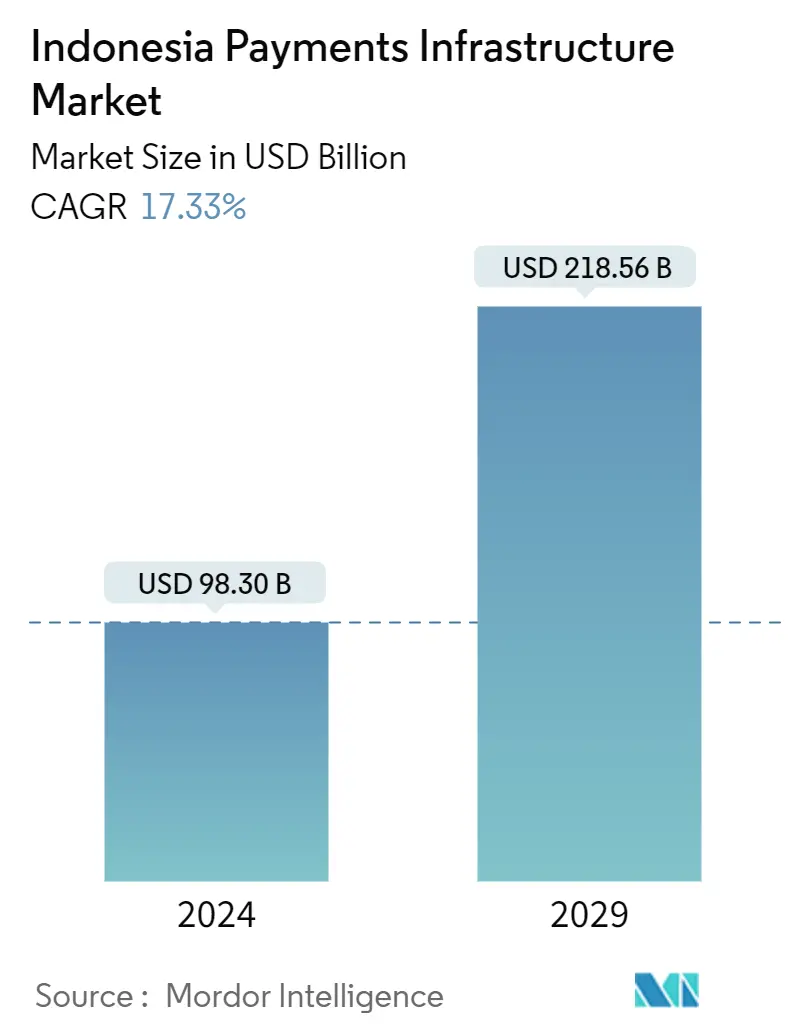Market Size of Indonesia Payments Infrastructure Industry

| Study Period | 2019 - 2029 |
| Base Year For Estimation | 2023 |
| Market Size (2024) | USD 98.30 Billion |
| Market Size (2029) | USD 218.56 Billion |
| CAGR (2024 - 2029) | 17.33 % |
| Market Concentration | Medium |
Major Players
*Disclaimer: Major Players sorted in no particular order |
Indonesia Payments Infrastructure Market Analysis
The Indonesia Payments Infrastructure Market size is estimated at USD 98.30 billion in 2024, and is expected to reach USD 218.56 billion by 2029, growing at a CAGR of 17.33% during the forecast period (2024-2029).
The COVID-19 pandemic drastically changed the way consumers shop, affecting several verticals of the market. The retail sector witnessed a drastic change due to the pandemic. Consumers increased their use of various sales methods, such as curbside pickup, virtual consultations, contactless payment, and social commerce, i.e., shopping through social media. According to retail experts and shopper surveys, this new behavior is expected to stay during the forecast period. Hence, the demand for digital payment infrastructure improvisation is expected to increase due to the change in shopping behavior caused by the pandemic.
- The country has witnessed waves of digitalization and its diffusion across industries over the past decade. With the presence of connected devices becoming inevitable, the economic and financial landscape has changed significantly. Also, with current digitalization across industries, consumers are increasingly demanding fast, affordable, and safe financial services. Such trends have substantially increased the need for the evolution of payment methods across the world.
- Furthermore, due to the pandemic, Indonesia has seen a surge in digital adoption among consumers and an accelerated growth of both digital payments and e-commerce platforms. According to the Bank Indonesia (BI), the value of electronic money transactions reached IDR 201 trillion (USD 13.95 billion) in 2020, growing by 38.62% from IDR 145 trillion (USD 10.07 billion) in 2019. The adoption of digital and cashless payment methods has, in turn, spurred the growth of the adoption of POS terminals at various payment gateways.
- With the growing digital payment infrastructure in the country, the economic and financial authorities are facing policy challenges in the digital era. Bank Indonesia, in particular, strikes an appropriate balance between efforts to optimize the opportunities afforded through digital innovation with efforts to mitigate the inherent risks.
- For this, the Indonesia Payment System Vision and Indonesia Payment System Blueprint for 2025 provided an unambiguous direction in terms of exploiting digitalization while implementing Bank Indonesia's mandate in terms of currency in circulation, monetary policy, and financial system stability. The Blueprint comprises five visions of the Indonesian Payment Systems 2025, further translated into five major initiatives and manifested into 23 key deliverables implemented in stages from 2019 to 2025.
- With the Indonesia Payment Systems Blueprint 2025, the country aims to make digital innovation accessible for 91.3 million unbanked people and 62.9 million MSMEs in Indonesia to formal economics and finance in a sustainable manner. Thus, all efforts are directed toward a stronger and more evenly distributed Indonesia in the future.
Indonesia Payments Infrastructure Industry Segmentation
The Scope of the report includes:
Indonesia Payments Infrastructure Market Size Summary
The Indonesia Payments Infrastructure Market is experiencing significant growth, driven by the rapid digitalization and evolving consumer behaviors influenced by the COVID-19 pandemic. The shift towards digital and contactless payment methods has been accelerated, with consumers increasingly adopting curbside pickups, virtual consultations, and social commerce. This change has necessitated the enhancement of digital payment infrastructures to accommodate the growing demand for fast, affordable, and secure financial services. The market is characterized by the widespread adoption of electronic data capture (EDC) machines and mobile POS terminals, which have become essential tools for merchants across various industries. These advancements have led to strategic collaborations and innovations among solution providers, further propelling market growth.
The user base for digital payment methods in Indonesia is expanding rapidly, with a significant increase in e-commerce transactions and users. Major digital payment platforms like OVO, GoPay, and DANA are gaining traction, supported by strategic partnerships and collaborations with key players in the e-commerce and ride-hailing sectors. The market is moderately concentrated, with several players competing to innovate and differentiate their offerings. Initiatives such as the Indonesia Payment System Blueprint 2025 aim to integrate unbanked populations and MSMEs into the formal economy, leveraging digital innovation for sustainable growth. As the market continues to evolve, companies are investing in advanced digital solutions to enhance payment processing capabilities and address the needs of a diverse consumer base.
Indonesia Payments Infrastructure Market Size - Table of Contents
-
1. MARKET INSIGHTS
-
1.1 Market Overview
-
1.2 Enabling and Limiting Factors of the Indonesia Payment Industry
-
1.3 Consumer Payment Landscape
-
Indonesia Payments Infrastructure Market Size FAQs
How big is the Indonesia Payments Infrastructure Market?
The Indonesia Payments Infrastructure Market size is expected to reach USD 98.30 billion in 2024 and grow at a CAGR of 17.33% to reach USD 218.56 billion by 2029.
What is the current Indonesia Payments Infrastructure Market size?
In 2024, the Indonesia Payments Infrastructure Market size is expected to reach USD 98.30 billion.

